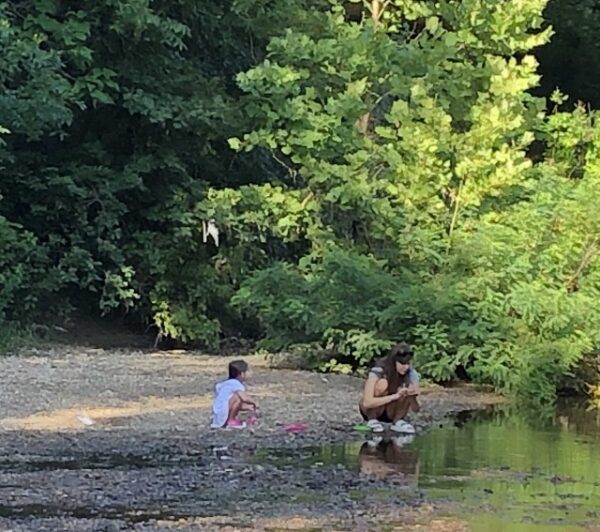
Post Oak Creek in Sherman teams with fossils waiting to be discovered. Most trek to the rural creek in search of shark teeth. For me, I’m content to gather any type of fossil. Summer, despite the heat, is a prime time to visit. The creek water level is low, exposing sandbars and allowing hunters the opportunity to walk miles up and down the stream bed.
Abundance of shells
In geological time, the formation exposed at Post Oak Creek is from the late Cretaceous period, some 90 to 66 million years ago. At that time, an inland sea covered the area. Seawater rose and receded with events like the formation of the Rocky Mountains.
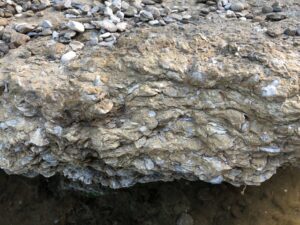
Walking in Post Oak Creek, I literally reached into the water and retrieved millions-year-old shells. No digging or much hunting required. Fossil shells, mostly oyster, layer the sedimentary rock lining sections of the stream’s bank, exposed over years of erosion. If you want to find a fossil, Post Oak Creek is the spot.
Shark tooth prospectors
Oyster shells abound throughout the creek area, but most visitors search for more elusive finds like shark teeth and the even rarer mastodon bone or tooth fragment. Shark’s teeth range in size from a quarter to dime, and their shape reminds me of a fat capital letter-T. Sharks have been swimming in oceans for 400 million years, and some of the teeth found at Post Oak are from now extinct Cretalamna and Petaldus species.
To successfully hunt teeth, you need simple tools and patience. It’s a little like panning for gold. Scoop up some stream gravel, place it in a sieve, and then sluice the sieve around in the water to rinse out clay and dirt. From there, you can examine the remaining rocks for fossil treasures. A garden trowel or small hand shovel works well for the digging. The day I visited, people used all sorts of things for sieves including box screens and vegetable colanders. In fact, one clever family used plastic hamburger baskets – the red ones with the side slats — as sieves.
Other Post Oak finds
In addition to fossils, the careful scavenger may find other artifacts like arrowheads, more recent bone from mammals, and old pottery and glass. Through the years, the town of Sherman was home to many different factories. One lucky hunter found an old 1890 bottle from the now defunct Sherman Bottling Works.
South Travis Street Bridge
Post Oak Creek meanders through south Sherman, but getting to the creek itself can be a challenge. The easiest access is at the Travis Street Bridge. Here you can park on the road shoulder and use a short trail down to the stream. The address, 2400 South Travis Street, Sherman, works well for directions in most mapping programs. The creek flows under US 75, and some fossil hunters recommend the access road near the interstate as another egress. My recommendation is to stick to South Travis Street. It’s true, this area is well-picked over from scores of visitors, however, just hike up or down stream to get to less congested hunting grounds.
When you go
Be weather aware. In the height of summer, creek levels are low, however, strong rains fill the creek rapidly and can create a dangerous flash flood situation. This is not a park. No restrooms. It’s good ol’ Texas-styled boondocks. Come prepared with hat, bug spray, sunscreen, and lots of water on hot days.
I wore wading boots, in part, to protect myself from water snakes. I confess, I was the only one in the crowd in my galoshes. Still be watchful and alert for snakes. Wear clothes you don’t mind getting wet and dirty. A hand trowel and sieve is all you need to hunt shark teeth, though I also recommend bringing lots of baggies for storing your finds. I found a gallon bucket worked well for lugging around my equipment and for storing larger finds. If you don’t mind carrying it, a small camp stool can be useful for sitting in the creek while you search the gravel for treasures.
After you come home
The website Your Fossil Adventure has a page dedicated to Post Oak Creek. Here you’ll find pictures identifying the fossils typical to the location. Also, if you aren’t sure what you have, the Facebook page Texas Fossil Hunting is wonderful. Post a picture of your find and ask for help identifying it.

 For a fun-filled family outing, head to Frisco and an evening with the Frisco RoughRiders. As American as apple pie, baseball is the quintessential family sporting event. The Frisco RoughRiders, a Double-A affiliate to the Texas Rangers, deliver baseball thrills at the fraction of the cost of a Major League Baseball (MLB) game.
For a fun-filled family outing, head to Frisco and an evening with the Frisco RoughRiders. As American as apple pie, baseball is the quintessential family sporting event. The Frisco RoughRiders, a Double-A affiliate to the Texas Rangers, deliver baseball thrills at the fraction of the cost of a Major League Baseball (MLB) game.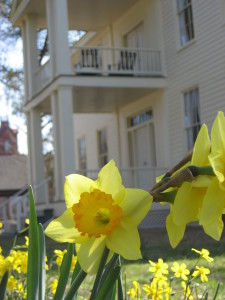 Historic Washington State Park transports visitors to the past when great western pioneers like Sam Houston and Davy Crockett traveled the Southwest Trail. It’s a hidden gem just twenty minutes off Interstate-30 in Arkansas.
Historic Washington State Park transports visitors to the past when great western pioneers like Sam Houston and Davy Crockett traveled the Southwest Trail. It’s a hidden gem just twenty minutes off Interstate-30 in Arkansas.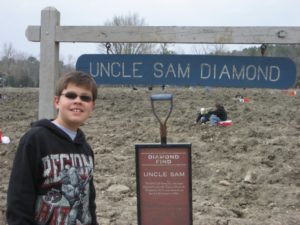 Prospectors, young and old, find treasures at Crater of the Diamonds State Park in Murfreesboro. The park is the only diamond mine open to the public – and the best part – you keep whatever you unearth.
Prospectors, young and old, find treasures at Crater of the Diamonds State Park in Murfreesboro. The park is the only diamond mine open to the public – and the best part – you keep whatever you unearth.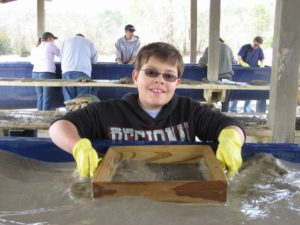 Park regulars use water to sluice dirt away from the stones and then sift through the remaining gravel in search of diamonds. With the right rhythm, the dense diamonds settle to the sluicing pan’s bottom separating out from the washed away dirt. This is hard work but fun to try. The park has two covered washing sheds for water sifting. It’s a lively place with fellow diamond hunters readily helping each other by offering tips and assistance to novice treasure seekers.
Park regulars use water to sluice dirt away from the stones and then sift through the remaining gravel in search of diamonds. With the right rhythm, the dense diamonds settle to the sluicing pan’s bottom separating out from the washed away dirt. This is hard work but fun to try. The park has two covered washing sheds for water sifting. It’s a lively place with fellow diamond hunters readily helping each other by offering tips and assistance to novice treasure seekers.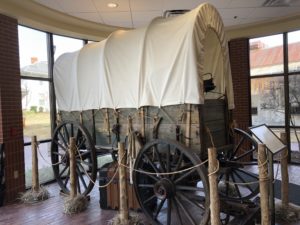 Are you looking for a Sunday family outing? Start with a Texas history appetizer at Frisco Heritage Museum and finish with family dining at Babes Chicken Dinner House.
Are you looking for a Sunday family outing? Start with a Texas history appetizer at Frisco Heritage Museum and finish with family dining at Babes Chicken Dinner House.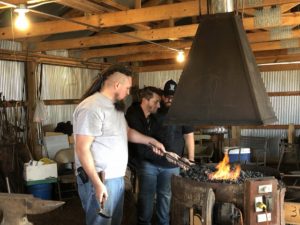 See smiths use forge and anvil to create nails and other objects, a crowd favorite with young scouts visiting the day of my visit. The Crozier-Sickles house, built in 1895, retains fixtures and furniture from the Crozier family. The old icebox in the kitchen and the hand-crank telephone contrast starkly to today’s refrigerators and smart phones. Other buildings include Lebanon Baptist Church (first built in 1883), a train depot, and a one-room schoolhouse replica.
See smiths use forge and anvil to create nails and other objects, a crowd favorite with young scouts visiting the day of my visit. The Crozier-Sickles house, built in 1895, retains fixtures and furniture from the Crozier family. The old icebox in the kitchen and the hand-crank telephone contrast starkly to today’s refrigerators and smart phones. Other buildings include Lebanon Baptist Church (first built in 1883), a train depot, and a one-room schoolhouse replica.